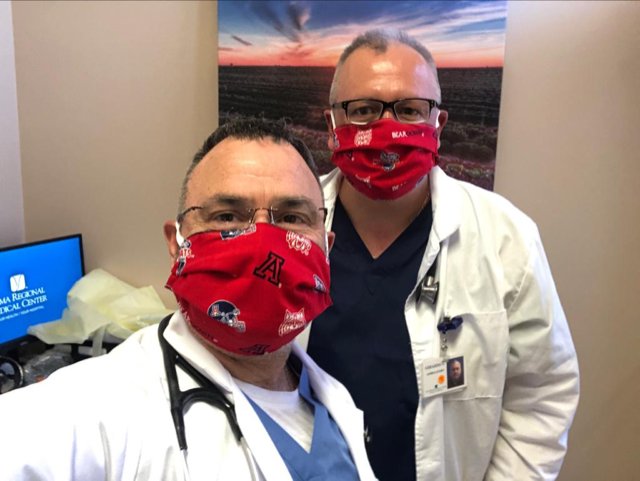Nurses Fighting COVID-19: UArizona Nursing Alumnus Shares Community Efforts and Updates at the U.S.-Mexico Border Near Yuma
Last year for Nurses Week, we paid tribute to an accomplished University of Arizona College of Nursing alumnus, the Reverend Dr. Rudy Valenzuela, pastor of Holy Spirit Church in San Luis Rio Colorado, Sonora, Mexico. A proud Wildcat Nurse, Dr. Valenzuela earned his Master of Science in Nursing (MSN) in 2002 and Doctor of Nursing Practice (PhD) in 2010. He is a family nurse practitioner at Yuma Regional Medical Center (YRMC) San Luis Primary Care as well as director of Clinica Santa Maria de Guadalupe, a full service health clinic serving the poor and underserved on both sides of the U.S.-Mexico border, with more than 50,000 visits a year.
As with most health care providers during the evolving COVID-19 crisis, Dr. Valenzuela’s work has been significantly impacted. As the World Health Assembly and the American Nurses Association celebrate the Year of the Nurse and the Midwife, we want to hear from UArizona Nursing alums on the frontline of the battle against COVID-19. As part of this new series, we caught up with Dr. Valenzuela to learn about his greatest challenges and accomplishments during this difficult time.
"The effects of this pandemic will last long after the initial curve flattens. However, we are confident that a new day will rise and darkness will be dispelled. Our call as nurses compels us to hope so and to work to make that day shine again on all humankind," ~ Rev. Rudy Valenzuela, PhD, NP, FAANP
From Dr. Valenzuela:
The COVID-19 pandemic has reached the U.S.-Mexico border, with 15 cases in Yuma County, and 2 confirmed cases in San Luis Rio Colorado as of April 4.
Thus far, binational government officials and health leaders at the federal, state, and local levels and the residents of both sides of the border have been able to slow down the spread what would otherwise be a catastrophic pandemic in this area. Yuma county has 32 “staffed” ventilators, and San Luis Rio Colorado has three ventilators.
The suggested guidelines by the World Health Organization, the Centers for Disease Control, and the local Health Departments on both sides of the border have been implemented both at YRMC Primary Care Clinic [in San Luis, Arizona] and Clinica Santa Maria de Guadalupe in San Luis Rio Colorado [in Mexico].
At Clinica Santa Maria de Guadalupe, we are partnering with the local General Hospital, which has been designated the COVID-19 hospital. About 40 patients have been referred this past week [the week ending April 3rd] due to the presence of symptoms and risk factors among these patients.
There is a shortage of personal protective equipment (PPE) on both sides of the border, but, as it is said, need is the mother of invention. Staff at both clinics have come up with ingenuous solutions to the current PPE shortage. For example, cloth masks have been made to prolong the life of N95 masks. At Clinica Santa Maria de Guadalupe, cloth gowns and homemade face shields have been made by the nurses to protect staff and patients.
Both clinics continue to be open daily, offering the availability of “virtual consults”, that is, phone calls to patients so as to avoid unnecessary traveling.
As for the other part of my work here at the U.S.-Mexico border, churches have been closed for about 10 days. No liturgical services are offered in the church to avoid gathering of people. This has given me the opportunity to utilize social media in order to reach people. Holy Week services will be done in isolation, but transmitted via social media.
Many people are currently unemployed on both sides of the border. The harvesting season is over in the U.S., and many sources of employment, like maquiladoras, restaurants, etc. have been closed in San Luis, thus leaving many people stranded financially.


